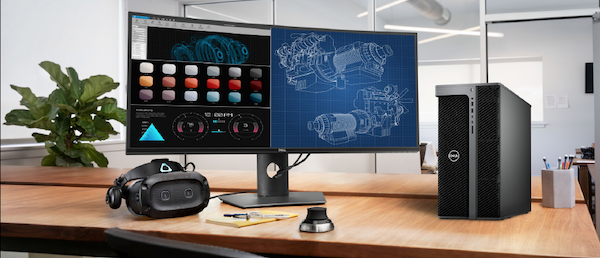
Image courtesy of Dell Technologies.
Latest News
May 12, 2023
As designs become more complex and the need to iterate and innovate more quickly increases, design engineers need access to more compute resources to complete their work. These designers are not only required to work with larger and more complicated models, but also have to perform analysis and simulation at the desktop, while also generating high-quality renders, and using office productivity and collaboration tools.
For engineers using a workstation that is more than a few years old, that can mean that an upgrade is in store. But given the size of the investment that a professional engineering workstation represents, how do you know when the investment is worth it? How can you justify an upgrade, particularly when IT budgets are under pressure?
The good news is that for designers looking for a power boost, there are some brand new workstations coming to market that include new generation CPUs from Intel and more powerful NVIDIA RTX™ GPUs.
The key to managing an upgrade is understanding how your workflows might be changing, and how your software has been upgraded to take advantage of new processors. In some cases, if the workstation is relatively new, you may just need to upgrade a component – i.e., add a more powerful GPU or more RAM.
But if a review leads the team to believe the CPU, RAM and I/O all need upgrading, realistically that means a new workstation is in order.
Making the Case for a New Workstation
One common problem customers and vendors notice when talking about engineering workstations is how to deal with company IT departments. Many have established specifications for company computers that don’t factor in the engineering software’s more demanding nature. The hardware needed to run Microsoft Excel is very different from what is needed to run SOLIDWORKS.
Every company has its own twist on this, but it usually revolves around resistance from IT for requesting workstations, or total lack of an IT department. When there is a functional IT department that pushes back on a request for more powerful computers, it can usually be solved by doing internal competitive benchmarking or involving a vendor in the conversation to help educate IT staff about engineering needs.
When there is no IT department to coordinate new workstation purchases, it then falls on the CAD manager or someone in engineering management to help the company understand the value of using engineering workstations and of upgrading them regularly – specifically, make sure management understands the high value of an engineer’s time, and how sluggish workstations can impact productivity.
The combination of new, faster CPUs and powerful GPUs provides new workstations with the power needed to quickly perform simulations, manipulate large CAD models, and (if necessary) generate high-quality renders. They can also handle AI-based applications that are increasingly playing a role in design.
An upgraded workstation can also enable more efficient multi-tasking. Engineers not only need to be able to run simulations in the background while they work in their CAD programs; in many cases, their other productivity applications (email, Microsoft Teams, video conferencing, etc.) are putting more strain on the CPU and memory. A workstation upgrade may be required just to keep up with the number of resources that all of the applications on the computer demand.
New Dell Technologies Precision workstations, for example, offer the latest generation of Intel Xeon CPUs and support for the latest NVIDIA RTX™ Ada Generation GPUs, in addition to more memory and storage.
The Precision 5680 supports up to the Intel Xeon W7-2495X processor, and two NVIDIA RTX GPUs. It also offers 56TB of storage and 2TB of 4800MHz DDR5 memory.
The 7960 supports Intel Xeon (350W) 56-core CPUs and can accommodate four NVIDIA RTX GPUs. It also offers 4TB of memory and PCIe Gen 4/5 slots.
The 7960 tower has been reconfigured to support a single 56-core CPU and up to two NVIDIA RTX 6000 Ada GPUs, offering a massive amount of compute power for simulation and rendering, as well faster performance for both single and multithreaded processes.
On the mobile workstation side, all of the Dell Precision workstations now offer 13th Gen Intel Core Processors (i5, i7 or i9, depending on the model), as well as next-generation NVIDIA RTX Ada Generation laptop GPUs, and memory has been upgraded to DDR5.
The Dell Precision 3000 series mobile workstations are targeted at standard 3D CAD work. The 5000 series units offer improved graphics performance in a thin and light form factor. For users that need to maximize performance for 3D CAD, large assembly work, and simulation and analysis, the 7000 series computers offer the best graphics and compute performance.
The top-end mobile workstations can now act as replacements for some older tower systems, giving engineers comparable or better performance, but in a form factor that can travel with them to client facilities, job sites, or home. That boosts the return-on-investment story for these workstations as they not only provide better performance, but also offer increased mobility and flexibility.
You can learn more about Dell Precision workstation configurations here and the NVIDIA Ada Generation GPUs here.
More Dell Coverage

More NVIDIA Coverage
Subscribe to our FREE magazine, FREE email newsletters or both!
Latest News








